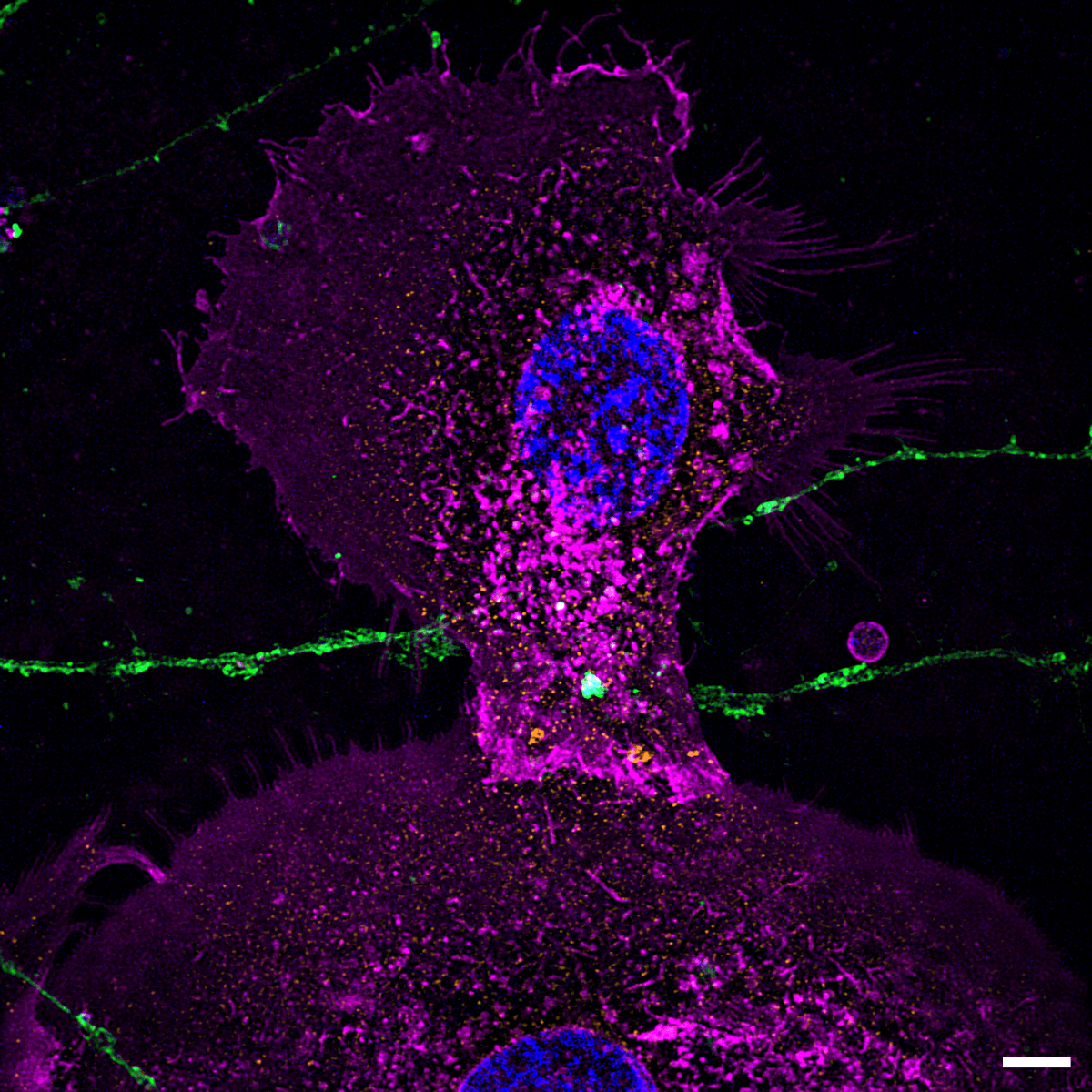A tickly itch, a painful scratch, or the feeling of a refreshing breeze—the skin is teaming with nerve endings that drive these sensations. Scientists are getting into the epidermis to explore how skin and nerve cells interact.
Peering through a microscope at skin tissue, researchers struggle to tease apart the intricate connections occurring inside tight bundles of skin and nerve cells.1 However, recent advances in microscopy have helped solve this intractable problem. Published in eLife, Nurcan Üçeyler, a neurologist at the University of Würzburg, and her colleagues used emerging imaging techniques to discover that nerve fibers not only weave around skin cells but also pass through them.2 The findings intimate a route by which skin cells transmit sensory signals to the nervous system.
“The skin is basically the window to the outside,” said Kathryn Albers, a neuroscientist at the University of Pittsburgh who was not involved with the work but reviewed the study. Despite this, scientists have long overlooked the role skin cells play in nerve stimulation. Üçeyler hopes that their findings will open new doors for research. “I think we’re at the beginning of changing minds,” she said.
A chance discovery made by Christoph Erbacher, then a doctoral student in Üçeyler’s laboratory, set the project in motion. “He had started working on his PhD thesis on a completely different topic,” Üçeyler said. However, when Erbacher looked at skin tissue under the microscope, he noticed that nerve fibers did not just grow around skin cells but, to the whole team’s surprise, tunneled straight through them. Eager to inspect these interactions in closer detail, the team turned to state-of-the-art imaging strategies that zoom deep inside cells to bring fine structures into view.
Structured illumination microscopy, a technique that takes multiple snapshots of a sample under different patterns of light, allowed Üçeyler and her team to acquire super-resolution images of skin tissue. With the help of fluorescent antibodies that bind specifically to nerves, they located nerve tunnels passing through skin cells. Then, to capture the cell’s interior architecture, they used electron microscopy.3 The combination of the two strategies, called correlative light and electron microscopy (CLEM), allowed the researchers to see which architectural details corresponded to the fluorescently-stained nerve fibers.4
A single snapshot of a cell can only reveal so much. By imaging several layers in a sliver of tissue, the researchers could determine whether a nerve fiber tunneled through a cell rather than over or under it. They scrolled through cross-sections of the cell, starting at the base and moving up. “All of a sudden, the fiber appears, and you can very clearly see you’re in the middle of the cell,” Üçeyler said.
Examining the close-up architectural details afforded by CLEM, the researchers noticed that the tunneling fiber, as thin as one micrometer in width, did not puncture the skin cell membrane and poke into the cytoplasm, like a needle piercing through flesh. Rather, the membrane ensheathes the fiber, like rubber insulation around electrical wires.

Researchers captured nerve fibers (green) tunnelling through skin cells (magenta) using cutting-edge microscopy. Scale bar = 5μm
Christoph Erbacher
With a detailed view of skin-nerve connections, the researchers explored whether proteins responsible for transmitting signals accumulate on these tunneling fibers. Using a flurry of fluorescent antibodies to search for such a protein, they found that connexin 43, a protein that normally participates in communication between skin cells, decorated the nerve fibers.5 Connexin 43 aggregates in a ring to generate pores in the cell membrane that allow entry of chemical signals such as calcium ions.6 Üçeyler’s team also found that the calcium ion level spiked inside the cells when the nerve fibers tunneled through, which suggested that the two cell types communicate.
What started out as a chance observation may have implications for healthcare down the road. This skin-nerve cell link could inform research on nervous system disorders that affect the skin. For example, small fiber neuropathy causes a chronic, persistent burning pain on the skin, and Üçeyler hopes that future studies will reveal whether nerve tunnels play a role in the condition.7 Currently, the few treatment options that exist target the nerves directly, but researchers may one day develop therapies that target the skin cells instead.
Before that can happen, scientists must first scratch deeper to unravel the biology of these nerve tunnels. Albers would like to know how these tunnels entwine with skin cells as they migrate from the base layer to the skin surface. She also wondered if nerve fibers tunnel into other cell types found in skin tissue, such as immune cells, and what that crosstalk between cell types might achieve.
“No one tissue exists alone; everything communicates at some level,” said Albers.
References
- Lefèvre-Utile A, et al. Five functional aspects of the epidermal barrier. Int J Mol Sci. 2021;22(21):11676.
- Erbacher C, et al. Interaction of human keratinocytes and nerve fiber terminals at the neuro-cutaneous unit. eLife. 2024;13:e77761.
- Titze B, Genoud C. Volume scanning electron microscopy for imaging biological ultrastructure. Biol Cell. 2016;108(11):307-323.
- de Boer P, et al. Correlated light and electron microscopy: ultrastructure lights up! Nat Methods. 2015;12(6):503-513.
- Langlois S, et al. Connexin levels regulate keratinocyte differentiation in the epidermis. JBC. 2007;282(41):30171-30180.
- de Bock M, et al. Connexin 43 hemichannels contribute to cytoplasmic Ca2+ oscillations by providing a bimodal Ca2+-dependent Ca2+ entry pathway. JBC. 2012;287(15):12250-12266.
- Hoeijmakers JG, et al. Small-fibre neuropathies—advances in diagnosis, pathophysiology and management. Nat Rev Neurol. 2012;8(7):369-379.
